Back towards the beginning of this blog, I gave some of the
deep historical background to "
Logan," my character. I told of the ruined Highland Clan, the Lairds of Restalrig, and my own exploration of
Leith. My fictional bio reads, "Growing up in Leith,
Logan learned both the ways of the sea in the Firth of Forth and the North Atlantic and the ways of the smuggler in the difficult times after the
Union of the Crowns in 1707. As a proud Scot opposed to English oppression,
Logan stood with the Jacobites in the Battle of Preston." Now I want to tell this tale, partly as an exercise in bringing various sources together, partly as a warm up for actually
writing about
Logan.
Warning, this is a LONG POST.
 |
| King Robert II of Scotland |
Let's start with a a little royal history. The
Stuarts had been the Kings of Scotland almost as far back as the legendary
Robert the Bruce, King Robert I. His daughter married the "High Steward of Scotland," i.e. "Stewart" or "Stuart," and their son became
Robert II, first of the Stuart Kings. The Stuarts ruled
Scotland through the 14th and 15th centuries. In 1503, James IV of
Scotland married King
Henry VII's daughter,
Margaret Tudor, and, with the birth of their son, the Stuarts now had a claim on the throne of
England. This led to the much-storied conflict between
Henry Stuart, Lord Darnley; his half-cousin,
Mary, Queen of Scots; and
Queen Elizabeth I. Although Mary lost her head, her cause eventually won. When
Elizabeth died without an heir, it was the son of Mary and Lord Darnley,
King James VI of Scotland, who peacefully gained the throne of
England, Scotland, and
Ireland with the
Union of the Crowns in 1603.
 |
| King James VII and II |
The years of King James VI and I--sixth King James of
Scotland, first King James of
England--became known as the "
Jacobean era," Jacob being the original Hebrew form of the name James. James resided over a grand time of arts and science, including the heyday of Shakespeare. Unfortunately, the time of the Stuart Kings was also a time of serious conflict. Catholics and Protestants continued their battle.
Cromwell led his Roundheads in the
English Civil War and executed
King Charles I in 1649. 11 years later, the
Republican Interregnum ended, and King Charles I's son returned from exile and was crowned
King Charles II, succeeded in 1685 by
King James VII and II. This last Stuart King was too nice for his time: In addition to being a Catholic, he proposed tolerance for Catholics and Protestant Dissenters alike. He was also a believer in absolute power for the King, which did not fly well with the political establishment. Finally, the King revived the "
Auld Alliance" between
Scotland and
France.
This was too much for the English Parliament to bear, and in 1688, when the King announced that his wife had given him an heir--and thus another Catholic King--action was finally taken.
William of Orange and his wife
Mary, daughter of King James, were "invited" to overthrow the King. James fled to
France. This event is called by some the "
Glorious Revolution" or the "Bloodless Revolution," but the latter term is very much inaccurate. It was, naturally, the Scots (and the Irish) who resisted.
Viscount Dundee raised an army of Highlanders in support of James.
Dundee was killed at the
Battle of Killiecrankie in July 1689. Although those faithful to James fought on, after defeat in
Scotland at the
Battle of Dunkeld and in
Ireland at the
Battle of the Boyne, the clans formally surrendered in 1692. Thus ended the first "
rising" of what came to be called the Jacobite cause--the rebellious effort to restore the Stuart line to their "rightful" place.
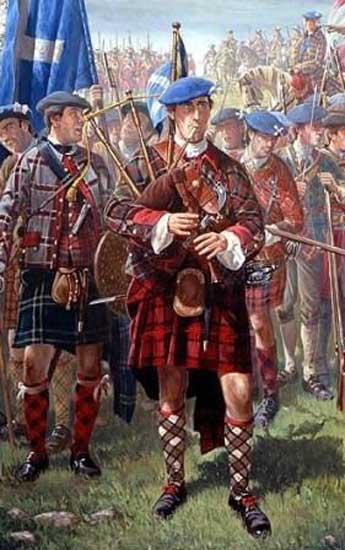 |
| A depiction of a Jacobite army |
Jacobitism was about a lot more than restoring a royal lineage or even Catholics and Protestants. Religious affiliation was not even a clear dividing line. Most of the fighting forces came from the
Highlands, and they were predominantly Episcopalian, not Catholic. In the Lowlands, as well as in northern England, the most fervent supporters of the Jacobite cause were either persecuted Catholic gentry and disempowered Episcopalians. Among the Highlanders, it was scarcely about religion at all and more about inter-clan politics and especially resisting the expansionist (and Presbyterian)
Campbells. The Jacobite cause in Scotland at large was increasingly romanticized into a sort of struggle for independence, especially after the Acts of Union in 1707 created the "United Kingdom" and poverty and famine became widespread. Among others, Jacobitism was a matter of political expediency. Rich politicians of the time were divided into the warring camps of traditionalist
Tories in favor of the old monarchy, with whom they had favor, and nonconformist
Whigs in favor of "institutional monarchy" in which the Parliament itself, and thus the politicians themselves, were in control. Religion, class, politics, clan rivalries, and nationalism thus all wove together to create Jacobitism. It was the many reasons that people became Jacobites that would eventually lead to its failure.
The situation for the Jacobites only worsened in the early 18th century. The deposed King himself died in 1701. His son, who some European courts recognized as King James III and VIII, became the new claimant, identified by his supporters as "The King Across The Water" and by his opponents as "
The Old Pretender." The same year, the
Act of Settlement was passed, putting the Protestant House of Hanover next to the throne. In 1702, King William died, and Mary's sister
Anne--keep in mind also a daughter of the late King James--gained the throne. This was the last gasp of hope for any maintenance of the Stuart line. The ratification of the Acts of Union by the Scottish Parliament was a call to arms for the Jacobites, and in 1708 James attempted to return to Scotland accompanied by a French fleet that included 7 men-of-war and 21 frigates and an army of over 5,000 troops. They were rebuffed with the appearance of the English fleet, 28 ships, in the Firth of Forth. They considered landing north at
Inverness but were driven back to France by a storm. As if hopes had not already been dashed, Queen Anne died without an heir in 1714. The waiting Hanoverian prince was quickly swept in from Germany by the Whigs and crowned
King George I. With the new King behind them, the Whigs took total control, not only depriving the Tories of any political power but also prosecuting them for past actions. The Whigs would maintain power over Parliament for decades. These events sent the Jacobites, who had until then been plotting in pubs and evading detection, into desperate action. The scene had been set for what is now called the
Jacobite Rising of 1715, what is sometimes called simply "The 'Fifteen."
 |
| The Earl of Mar |
The leader of this rebellion was
John Erskine, 22nd Earl of Mar. This was profoundly unfortunate for the Jacobite cause. Mar was a politician and an opportunist, not a revolutionary and certainly not a strategist. He was a Scot and an Episcopalian, but over the course of his political career he switched between Whig and Tory depending on which would keep him in favor, gaining him the nickname "Bobbin' John." As a signatory on the Act of Union, he simultaneously alienated his countrymen and ingratiated himself to Queen Anne, who eventually appointed him Secretary of State for Scotland. The takeover of King George I and the Whigs meant that he was deprived of his position under the old regime and at risk of impeachment. The Jacobite cause was his only avenue to self-preservation, and it was time to bob again. In August, 1715, Mar, having been in communication with James, ventured out of London. He called the Jacobite clan chiefs to
Braemar, first apologized, and then raised the standard of the Stuarts...and the ball fell off the top of the flagpole. In spite of this bad omen, the sympathetic clans rallied to the cause. By the end of September, Mar had 5,000 men and control of
Perth, which meant control of much of northern Scotland as well as confidence amongst his followers. In early October, the
Laird of Borlum arrived with 500 loyal
Mackintoshes. More soldiers arrived the next day, and the Jacobite army totaled above 8,000. Then Mar made two bad decisions. The first was, rather, indecision. Rather than march at full strength to take on the government troops under the
Duke of Argyll at
Stirling, Mar simply waited. The second was to send Borlum and his best troops south to join forces with Jacobites in Northumberland and to invade England directly.
The background has ended. Enter Logan. Allow me from here on to insert a little fiction into the facts.
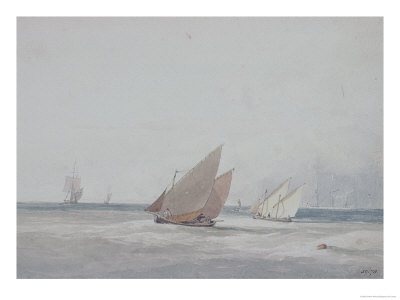 |
| "Leith Roads with Shipping" by Andrew Wilson |
In my imagination, sailor Logan had been a part of the smuggling network out of Leith, working around the Forth. Most of his cohorts--and himself--were driven by need, and some of them were driven by the Jacobite cause. Perhaps Logan still felt the sting of the ridicule of his ancestors, the Restalrig Logans I've talked about before, and had an angst that was fueled by anti-establishmentism. There's a little literary tickle to bring a woman into the mix, perhaps the daughter of a noble who had not only inherited her father's dedication to James as a religious and national hero but also become active in the underground Jacobite network. Motivated by equal measures of desperation, nationalist pride, and love for this mysterious, passionate, and driven woman, Logan itched to rise to the occasion and prove his worth. Leith waited in a mix of fear and excitement as the 'Fifteen unfolded. Logan perhaps sat in a pub with his neighbors and cronies, contemplating the possibilities of war. Will Argyll prevail, and will Scotland suffer further abuse from the British? Will we be called to join James and fight? And if James wins, will Scotland stand proud again?
Yeah, yeah, very romanticist. Keep in mind all of this is the setup for a fall, what will make Logan "blue." And so back to history. I am drawing much of the detail here from
History of the Scottish Highlands, Highland Clans and Scottish Regiments, as posted on Electric Scotland.
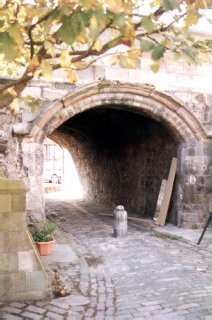 |
| Citadel Gate, the last remnant of Leith Citadel |
Early October, 1715. Mar has called upon Old Borlum to lead the expedition to the south. With a handpicked army of 2,500 men, including all of his own Mackintoshes, he ventured out of Perth towards the Forth. A diversionary force made immediately for the English ships at anchor in Leith Roads, but Borlum's men embarked from various places nearly 20 miles from the enemy fleet. By the next morning all short of two boats had made it safely across. Borlum still had about about 1,600. Edinburgh was in a frenzy, with no real troops to defend against the Jacobites, and frantically called volunteers to defend the city. Learning of the chaos in the capital, Borlum disregarded his orders to march directly to England and decided to attempt Edinburgh. On October 15th, he took Leith and set up camp in the old Citadel constructed in Cromwell's day, all but dismantled but still a defensible position. Barricades were erected. Brandy and provisions were taken from the Custom House. Some locals hid, but others joined Borlum. Among them was Logan, finally getting his chance.
Argyll's troops arrived from the east, but they were at a major disadvantage. They had no artillery, while Borlum had taken cannon from ships in the harbor and mounted them on the ramparts, which he discharged at Argyle to make his point. Argyle retreated to to Edinburgh for armament. Knowing Edinburgh could not be his, Borlum snuck out of Leith in the night and headed east. Mar, having received a report from Borlum, sent troops from Perth towards Argyle's base in Stirling. This was nothing more than a feint; Argyle's men recalled to Stirling, Borlum was free to run and resume his mission to England.
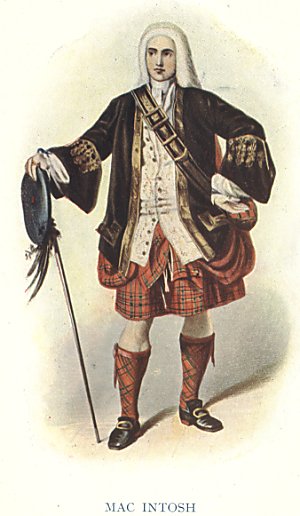 |
| "Mac Intosh" |
A moment should be taken to imagine Borlum's men. Class and geographical distinctions created strong divisions. Do not forget that feudalism was not dead. At the top of the pyramid were men like Borlum, hereditary chiefs who inspired both loyalty and fear amongst their clansmen. The chiefs wore the tartan kilt but also the full wig of a gentleman. They were armed with the best: a
basket hilt sword, a traditional
dirk, and a brace of shiny
Murdoch pistols. Below him were his real fighting force, far less adorned, stripped from the full
great kilt for easier mobility in the fight, armed with broadsword, and protected by
targe. At the bottom of this hierarchy was the common clansman, some of whom were servants, taking up the rear with perhaps little more than a
Lochaber axe or a club. The Lowlanders made up a different section entirely. Most were horsemen wearing their regular civilian clothes, but only the higher classes would actually have been properly equipped. In short, unlike the organized Redcoats of the government troops, the Jacobites were quite the motley crew. Logan, a seaman from a once powerful family now reduced to criminality to survive, would have been a misfit even here. (My source here is Barthorp and Embleton's short but detailed
The Jacobite Rebellions 1689-1745, from the
Men-at-Arms Series.)
The march from Edinburgh, from the sources I have read, wasn't exactly the trials of war. Their first stop was
Seton House, where the men were "in no hurry to leave," because for three days they "fared sumptuously upon the best that the neighborhood could afford" (
History of the Scottish Highlands). Having finally received orders to head south, their next stop was
Longformacus, where Borlum had reason for revenge against a Doctor Sinclair and thus ordered his men to plunder the estate, which they did, naturally, with much pleasure. On October 24th, Borlum's army reached
Kelso in the Scottish Borders, where they rendezvoused with Scottish forces under
Lord Kenmure and
Northumbrian forces under Tory MP
Thomas Forster, bringing the total army to about 2,000. After "proclaiming the Chevalier"--that is, claiming James the rightful King and this his possession--they again sacked the town. I imagine Logan at once feeling dismayed that this just cause, the fight for Scotland, had been reduced to plundering, and getting a taste for, well, the pirate way.
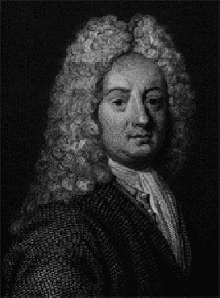 |
| Thomas Forster: Northumbrian Tory and would-be Jacobite commander |
The meeting of the three armies at Kelso was nearly the end of the endeavor, because no one could agree what to do next. The
Earl of Winton, a Scot who had joined the group with Forster, favored going north and coming up on Argyll's rear. Borlum, ready for real action, wanted to take on the government troops under General Carpenter that were quickly closing upon them. Forster and the Northumbrians wanted to head south into England, claiming they could bolster their strength with Jacobites in Lancashire. Four days later, with grumbling all around, they struck a middle ground and went south towards
Jedburgh to where they
thought Carpenter was, but their intelligence proved incorrect. There was no enemy to face and no clear goal. The Highlanders mutinied, refusing to march further; 500 deserted in disgust, and others were only convinced to follow Forster's direction after being surrounded by English horsemen. Logan would have been watching a rebellion being torn apart by its own internal schisms.
Forster was now in command. The army marched hard, a hundred miles in five days:
Langholm,
Ecclefechan,
Brampton. The Scots were less and less inclined to proceed, and although some were convinced with promises of riches, still more turned back. They almost faced opposition at
Penrith, but the local defense scattered in dismay when they saw the approaching army and especially the imposing Highlanders. The troops Forster had promised had not appeared. The plundering continued: At
Lancaster, "the Highlanders regaled themselves with claret and brandy found in the custom-house." As they approached
Preston, they finally got their reinforcements, and their numbers grew to a substantial 4,000. This army, however, had lost its Scottish fervor. Preston was also the end of the line.
 |
| A map of Preston, England, in 1715 |
I here add a further source, the
ScotsWars page on
The Battle of Preston. Preston was not an insignificant town. It was as old as Roman times, a prosperous marketplace since the Middle Ages, and almost exactly half way between Glasgow and London. When the Jacobite army entered Preston on November 9, 1715, they met no opposition, and the higher-class soldiers began wining and dining the local beauties. Two days later, they learned that they were being advanced upon not by General Carpenter but by
General Wills, who had left Manchester with six regiments expressly to stop Jacobite progress and taken up position in
Wigan to intercept the rebels at Preston. This news once again put the Jacobite leadership into confusion. Forster, not a military man at all but in command mostly because he was the only Protestant, was completely unnerved. Fortunately, the more experienced Borlum seized the moment and fortified the town and barricaded the roads. The battle began on November 12th. The Highlanders stood fast, pouring sniper fire onto the government troops and causing heavy losses. Purportedly, a drunken sailor manning two cannons from Lancaster fired grapeshot at Wills' troops to great effect...maybe Logan? Wills' next tactic was to scare the rebels out by lighting the town on fire, but not only was the wind against them but also the Jacobites returned the favor by setting aflame buildings the government troops had seized. The Jacobites had, thus far, held their own.
 |
| A Scots Dragoon |
The next morning, Carpenter arrived with 2,500 men. The Jacobite army was now totally besieged. The nervous Forster, without consulting the Scots, secretly sent a man to Wills to make an offer of capitulation. Wills outright rejected any treaty with rebels. The Highlanders, learning of Forster's deception, went mad, threatening anyone who would even consider surrender. Forster himself was fired upon. The next morning, however, the surrender was completed. Borlum only acquiesced when threatened by Wills with total annihilation of his men. Only 17 Jacobites had been killed, but government casualties were estimated at 300. Nearly 1,500 Jacobites were taken prisoner. Kenmure and the
Earl of Derwentwater, one of the Northumbrian Jacobite leaders, were taken to the
Tower of London and beheaded. Others were imprisoned, and some of those died there. The common soldiers were held for a month in the cold of Preston's church and driven to starvation. Many of the clansmen were sent to the New World. Borlum and Forster managed, eventually, to escape prison. By coincidence, on the exact day of the surrender at Preston, Mar and Argyll faced off at
Sheriffmuir. In spite of having superior numbers, Mar once more proved indecisive, and the battle was a draw. Mar was again back in Perth with no plan. When James arrived in Scotland in December, Mar's forces were drastically reduced, and Argyll was rapidly taking control. "The Pretender" simply returned to France, Mar following. The 'Fifteen was over. Thirty years later, the
'Forty-Five,' the Jacobites tried again, but with this defeat the Jacobite cause was lost for good.
And what of Logan? Stay tuned for Pt. III: escaping England, and turning pirate!










No comments:
Post a Comment